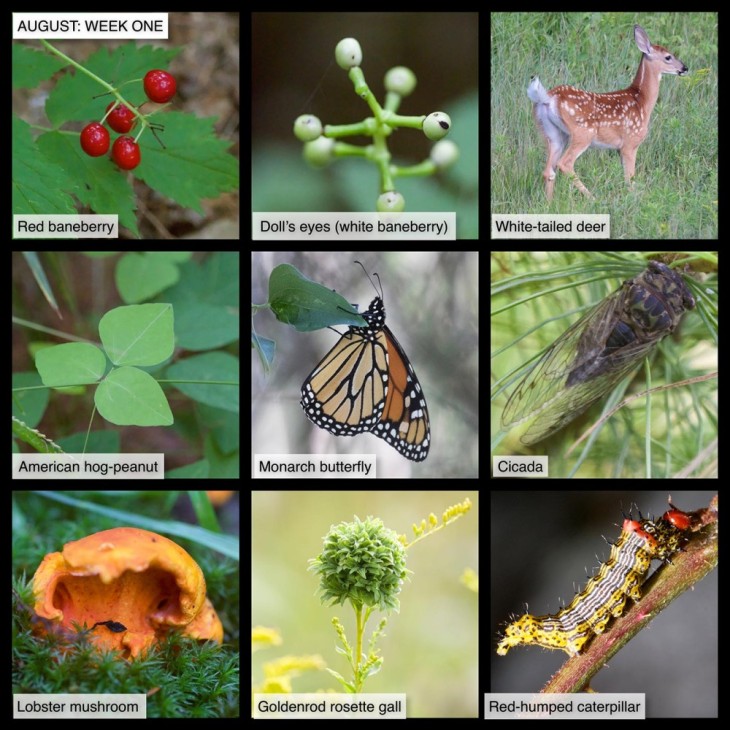This Week in the Woods, we’ve noticed more berries ripening, including red baneberry and its creepy cousin, doll’s eyes (white baneberry) which as its common name suggests, takes the form of a cluster of unblinking, lidless eyeballs staring up at you from the forest floor. Both species are highly toxic to humans, although they have some limited value as wildlife food (ruffed grouse, for example, will eat the berries of both species). Here’s a species profile on red baneberry from Adirondacks Forever Wild, with a link from that page to a similar profile on doll’s eyes.
This spring’s white-tailed deer fawns still have their spots, but they’re more independent now from their mothers, and lingering more out in the open. As explained in this article by the Quality Deer Management Association, the weaning process is often a slow one; although fawns are becoming less reliant on nursing, they may not fully wean until three or four months of age. This Outside Story essay by Susan Shea offers more detail about their development.
American hog-peanut, a nitrogen-fixing vine, grows both in the woods and in disturbed sites such as roadsides. It can dominate other plants, and for that reason has its detractors, but on the plus side it’s a host plant for those silver-spotted skippers that have been fluttering around the meadow all summer. Its name refers to its edible underground seeds. Here’s a profile from The Native Plant Trust.
We were delighted to see two monarch butterflies chasing each other around the meadow. There aren’t many of them around this year. Eastern monarchs are in trouble. They’re declining rapidly and experienced another drop in population (about 53%) this past winter, as explained in this AP report. On a happier note, many people are making an effort to plant milkweed and create more pollinator friendly habitat. Here’s an article about Pollinator Pathways from the summer issue of Northern Woodlands, a related link with more resources, and an Outside Story article about the Tillinghast family’s caterpillar raising adventure.
No, the neighbors haven’t purchased new power equipment. That’s just a male annual cicada performing a buzzy courtship song by vibrating his abdomen. Cicadas (there are many species) live most of their lives underground, where they feed on the sap of tree roots. In late summer, nymphs tunnel up from the ground, find a good perch (typically, the trunk of a tree), and pop out of their exoskeletons, emerging as winged adults. Here’s more information from National Geographic, and here’s a link to photo series documenting the emergence process in a dog-day cicada.
Lobster mushrooms, probably named for their color, aren’t actually mushrooms. They’re parasitic fungi that engulf mushrooms, and take on the shape of their meal/host. Apparently, they often smell fishy (which could be an alternative explanation for their name?). Here is a deep dive into the topic by mycologist Tom Volk.
Those bouquets of green leaves on the top of goldenrods are goldenrod rosette galls and they’re the work of a tiny fly. The mother midge subverts the goldenrod’s growth pattern to make a nursery for a larva. You can see more photos on the Project Noah site, and see this description by Mary Holland in her excellent Naturally Curious blog.
Finally, and most spectacularly, we found a cluster of red-humped caterpillars hiding out on a blackberry plant. The larvae of rather drab brown moth, Schizura concinna, these insects tend to stick together early in their caterpillar-hood but become more solitary as they mature. According to David Wagner, author of Caterpillars of Eastern North America, “collective warning displays, with the yellow-orange rears lifted into the air, provide quite a spectacle.” Which is what you see occurring in the photo. Wagner notes that if these caterpillars become even more agitated, they thrash and regurgitate fluid. Here are more photos from the Butterflies and Moths of North America Project.
In this difficult period, many of us find joy in observing local nature, and many families are seeking outdoor enrichment opportunities for children. Here are nine photographs taken this past week, most within 15 miles of the Northern Woodlands office in Lyme, New Hampshire. We hope you enjoy using this grid as a prompt for your own explorations, or as the basis for a game of family forest tic-tac-toe.
What are you seeing in the woods this week? Share your images with us on Facebook, or submit a special photo for possible inclusion in our monthly online Reader Photo Gallery.


